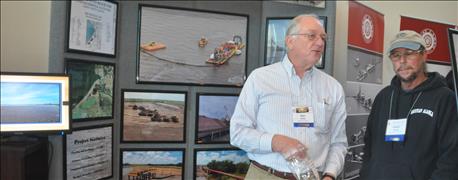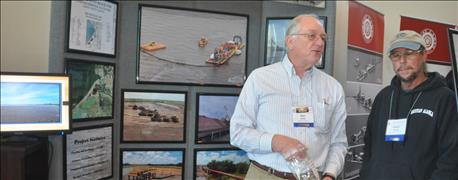
Three million cubic yards of sludge have been dredged out of John Redmond Reservoir and are now being dewatered in confined disposal facilities. By next year, those disposal ponds will be remediated and the land they are built on returned to grasslands or farmland.
The project, which started on a cold, gray day in May, cost more than $19.5 million and bought about three additional years of life for the reservoir, which has silted in at a rate in excess of Army Corps of Engineers projections.

DREDGING PROJECT: Officials from the Great Lakes Dredge and Dock company talk to attendees at the annual Governor's Conference on the Future of Water in Kansas about the project they completed this year to remove 3 million cubic yards of sedimentation from John Redmond Reservoir.
Matt Unruh, who was the Kansas Water Office water planner for the John Redmond project, said the lake has lost 40% of its water supply storage due to sediment. The loss of storage became apparent during the severe drought of 2012 and 2013 when lake levels dropped alarmingly low.
John Redmond is the municipal water source for 19 downstream municipalities and six industrial users, including Wolf Creek Nuclear Power Plant.
In 2013, the Corps approved a 2-foot increase in the conservation pool of the lake, which has helped improve the storage capacity of the lake. With the completion of the dredging project, the lake will now last through 2035. The goal for water officials is now to make it last until 2045, which is the ending date of the Wolf Creek operating contract.
Speaking to attendees at the annual Governor's Conference on the Future of Water in Kansas, Bryan Taylor with the U.S. Army Corps of Engineers said the effort to complete an environmental impact study for the dredging project was daunting.
That effort was centered largely on the confined disposal facilities. There were five containment ponds on nearby land, two on federally owned land and three on land owned by local farmers. The environmental impact study had to look at both the ecological and environmental impacts of removing soil to create the ponds and the infrastructure of containment and at the content of the dredged material to make sure it would not contain concentrated levels of contaminants.
He said that studies of the dredged material reveal that it is basically topsoil, although as it dries out it is extremely fine silt.
The project engineers stockpiled the soil removed to make the ponds, and it will be mixed with the dried silt and possibly with sand to make sure it is of equal or better quality than the original topsoil before it is returned to the fields in the disposal area.
The John Redmond project is the first of its kind to be conducted on a Corps lake but carried out by a state.
Stan Ekren with Great Lakes Dredge and Dock, the contractor on the project, said the John Redmond dredging effort can become a roadmap for the rest of the nation on how to complete this type of project. He said the company used a 22-inch electric dredge to remove material from the lakebed. The material was pumped through pipelines to the disposal sites.
"That was another initial problem," Ekren said. "We had started out with the idea of using a 16-inch dredge, but we realized that would not get the job done in the time frame allotted. So we moved up to 22-inch dredge, but that meant we were getting more than the 3 million cubic feet of disposal space, so we had to figure out how to take some of the water out right away.”
The mixed sediment and water was run through treatment filters and clean water pumped back into the downstream Neosho River.
Building the pipelines to carry the sediment required 30,000 feet of pipeline, capable of handling the pressure put out by the 3,500-hp pump to move the water to the disposal ponds.
The dredge arrived on 35 truckloads of parts and was assembled at the site. It took 60,000 hours of time before the 3 million cubic foot mark was reached.
"I am proud to say that we completed the job with no injuries and no reportable incidents," Ekren said. "We finished on time and on budget."
During the dewatering process now in place, that will be repeated again and again until as much water as possible is removed. The remaining sludge will then be left to completely dry out.
Another hurdle came up in June of 2015 when a key landowner said he had decided he wanted to sell his land for the project, not merely lease it.
Great Lakes Dredge and Dock purchased the land so the project could move forward.
Ekren said that after the land is remediated, it will be turned into grassland for pasture or back to cropland that can be leased to local farmers.
About the Author(s)
You May Also Like






